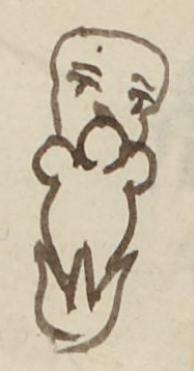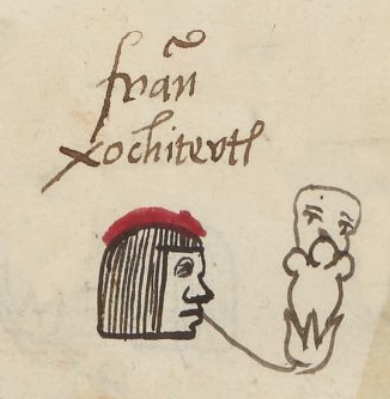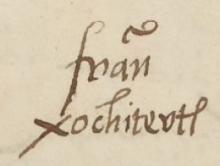Xochiteotl (MH500r)
This black-line drawing of the compound glyph for the personal name Xochiteotl (perhaps "Flower Divinity") is attested here as a man’s name. It shows an upright flower (xochitl) with a stem, base, and three petals. Coming up from behind the flower is a hairless head with two eyes and perhaps a nose showing. This anthropomorphic figure seems to point to the second part of the name, teotl, which can be a divine force or deity.
Stephanie Wood
One of the Matrícula de Huexotzinco glyphs in this collection, the one representing Teoxoch (MH524v), also has a face, and in that case, it is on the flower, not peeking out from behind it. See below. The glyph for Achiteotl also has a head and a face. These are interesting glyphs for those seeking to probe the meanings of teotl and their evolution in a Christian colonial context. Another compound for the name Teoxoch (also a woman's name) uses a stone to bring forth the Teo- syllable. A compound for Xochiteotl (there, a man's name) uses that same economy, in both cases avoiding any visual depiction of teotl. The use of a face here to represent divinity seems to show European influence.
Stephanie Wood
franco
xochiteotl
Francisco Xochiteotl
Stephanie Wood
1560
Jeff Haskett-Wood
flowers, flores, deidades, deities, divinidades, divinities, caras, nombres de hombres

xochi(tl), flower, https://nahuatl.wired-humanities.org/content/xochitl
teo(tl), deity, https://nahuatl.wired-humanities.org/content/teotl
"Flower-Deity" or "Sacred Flower" [H.B. Nicholson, in Mesoamerican Writing Systems, ed. Elizabeth P. Benson (1973), 28.]
posiblemente, Flor Divinidad
Stephanie Wood
Matrícula de Huexotzinco, folio 500r, World Digital Library, https://www.loc.gov/resource/gdcwdl.wdl_15282/?sp=79&st=image
This manuscript is hosted by the Library of Congress and the World Digital Library; used here with the Creative Commons, “Attribution-NonCommercial-ShareAlike 3.0 License” (CC-BY-NC-SAq 3.0).











